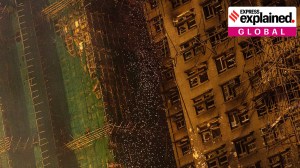Wankhedes house warming
Tracing a stadiums journey from the railway tracks.
From her window seat on a Churchgate local,Shivani Naik looks at Mumbai’s changing skyline
The curving wall in a tacky shade of light blue advertising a local product (in tackier dark blue) which is dubiously proclaimed to be world-famous in Mumbai this was the passing sight when you hit the home-stretch to Churchgate Station. All trains led to Churchgate merging into the shaded tunnel,and after the scenic ferns lined along Charni Road and the reassuring empty spaces of gymkhana grounds as Marine Lines whizzed by,the bustle of the city railways western line nerve-end beckoned. You could never tire of glimpsing the sea for the first time first time on that day,that is and only a fool preferred standing at the left-side gangway doors instead of inhaling the coolness of the sea-breeze on the right sea-front. Jarring this idyllic ride as the sea got hidden from view was the dirty and presently dull blue wall.
Imagine a cheap white-wash,and repeated layers to cover preceding peels except in a make-do blue. But then there was the Wankhede Stadium. Gloriously hidden beyond the 5 foot blue wall,simply because the absurd advertising seldom allowed you to look farther,it was an equally uninspiring grey shell of a structure,though you knew on the other side of those drab walls many had been mesmerised sitting on not-very-clean seats as cricketers had scripted many legends. On match-days,even the stray roars could get the daily commuters to wish the train moved a little faster towards the action.
Life chugged along,till Wankhede was razed down. The humdrum of a Mumbaikars travelling life then got accustomed to seeing piles of sand and rubble and frequently flying dust behind tin-curtains that revealed all through the gaps in between the makeshift screens of what was once the Wankhede Stadium.
The approaching World Cup had started buzzing on television,but Wankhede seemed to be worryingly and non-valiantly incomplete as 2011 neared. Till one day,mighty suddenly like realising a younger sibling having shot up a foot and many inches above you overnight the paneled many tiers of the stadium rose on the commuters horizon. Smart,shining,steel and sleek this outer wall of the Wankhede humbled its surroundings while jutting only slightly into the adjacent hockey territory.
The floodlights were always the beacon towers of big-time cricketing activity along the Marine Drive and its street-lamps necklace,but now this worms eye view from the outside held a certain awe and wonderment when gazing at the new Wankhede Stadium.
The World Cup takes a pit-stop at Mumbai this Sunday for the first time since 1996 and New Zealand and Canada will play out what will essentially be a recce day match for the stadium before the Sri Lanka-New Zealand skirmish next Friday and then,of course,the grand finale. It will be up to the two teams to give their thumbs-up to the outfield (which is newly carpeted) and the pitch (which hasnt been overhauled much from the old one,according to the curator),but for Mumbai the first game will be the starter,the second perhaps an aperitif as the city prepares for a feasting final.
Fans can recall their best memories the star-studded autograph book from the 90s which came with a flapping trick: with each flipped page,Kapil Dev launched into his delivery. Or the mad crowds being pushed around plenty and taking those little bruises home like scars of warriors in a stadium that had a next-to-nothing aesthetic appeal in its older version but still enjoyed the sea-breeze and famous cricketing tales of its own.
Now,with its bucket seats and its arched roofs and without the annoying block pillars that rendered many lines of vision useless,the Wankhede is a modern structure on the South Mumbai landscape.
The Wankhede now doesnt stand out as a sore thumb when seen in line with some of the other architecture of Marine Drive which boasts of the wood and stone carved walls of Wilson College,the terrifically stylish Art Deco frameworks of most of the other buildings and the steadfastly persisted with French windows. The trundle into the greenhouse-like Churchgate station also has a landmark,modern back wall of the stadium and its lovely blue panels to gaze at the little wall now dwarfed and put in its place by the stunning edifice taking foreground status.
- 01
- 02
- 03
- 04
- 05































